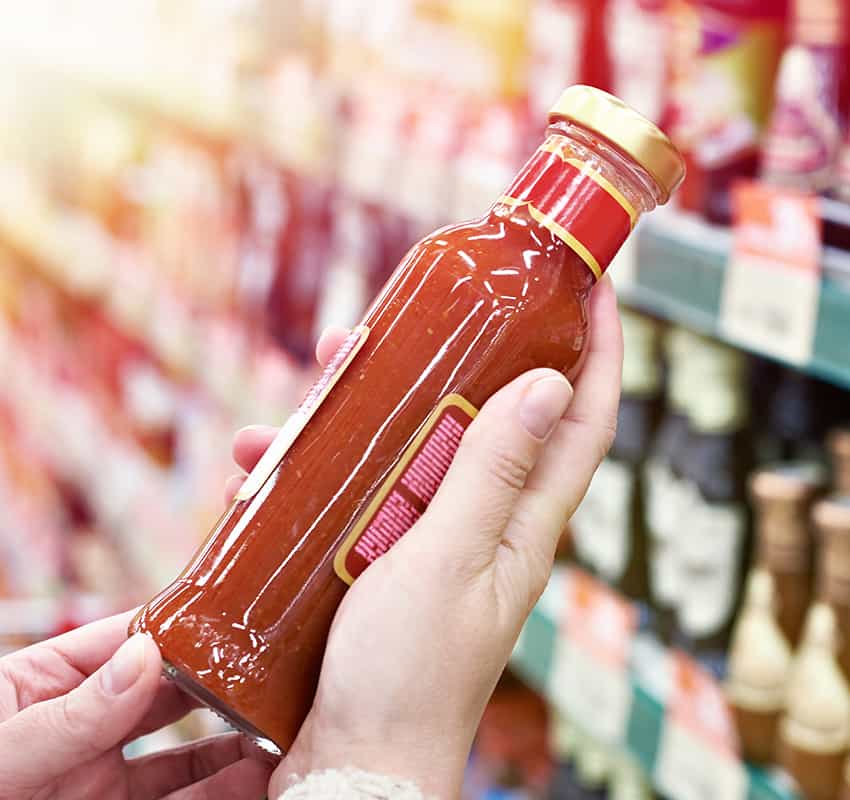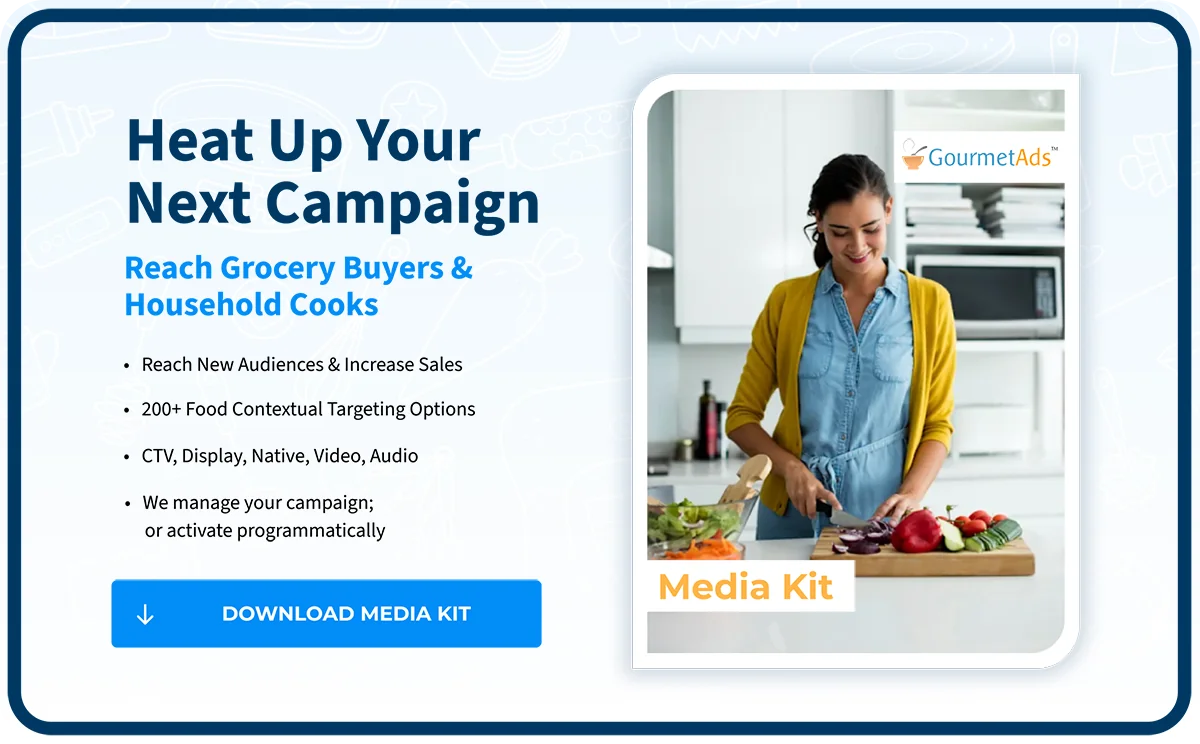Food Marketing
Food Marketing is at the cornerstone of what Gourmet Ads is about. Since 2008, we’ve provided Food Marketing and Food Advertising solutions to Food Companies and Grocery Stores around the world via our Managed Services and Programmatic Advertising Solutions. Gourmet Ads focuses entirely on reaching and engaging with end users, ie the household grocery buyer. We have discussed the best advertising techniques so that our readers never miss a chance to grow their business.
Gourmet Ads can work with you to develop a strategy to reach your target audience.
What is Food Marketing?
Food Marketing is defined as a series of marketing events that take place between a food company and a consumer.
Food companies frequently use generic marketing tactics and strategies that are used in the marketing of other types of products and services. A food advertising agency often uses the same tactics in the advertisement. Test marketing, segmentation, positioning, branding, targeting, consumer research, and market entrance strategy are all important subjects in food marketing. Furthermore, food marketing has few obstacles, such as dealing with a perishable commodity whose quality and availability vary depending on current harvest circumstances. Food marketing is quite different from food advertising. Food advertising techniques do not necessarily apply to food marketing because advertising and marketing are different terminologies. Marketing vs Advertising is an interesting topic because many advertisers believe they are the same terminologies. A food advertising agency must use both food marketing and food advertising to increase its customer base.
Food Marketing – R&D
Long before any product ever hits an assembly line, food companies undertake in-depth research and development. During this stage, food companies aim to understand what consumers are looking for via focus groups and then develop food product ideas that resonate with the target audience. This could be an entirely new food product or modifying an existing one, tweaking it to ensure that the product is on target.
Agency Holding Companies play an important role in the food marketing industry. These companies are in charge of managing and coordinating advertising and promotional operations on behalf of their food industry customers. During the development phase, companies often start how they plan to market the product. Some food industry giants spend a lot of money on brand development which allows them to generate more demand for their products and this makes consumers more willing to pay more.
Food Marketing & Packaging
Once an idea makes it through the test phase and the company determines there is a market for their food product, they need to draw attention to what type of message they want to send to their potential consumer. The majority of people make purchasing decisions when they see packaging visually, of food labels. It increases the convenience of the buyer. Food packaging is very important. Using specific colors in food labeling like red and yellow is said to have a psychological impact on people’s desire for food. However, a food product focusing on organic might feature more “earthy” colors compared to bright colors which might suggest they have artificial colors.
Culinary marketing is the process of advertising food, beverages, and culinary experiences to a specific audience in order to increase sales and generate revenue. From restaurants and food trucks to packaged goods and beverages, the food and beverage sector is huge and diversified. The vast majority of food marketing by major food and beverage companies in the United States promotes the sale of soft drinks, breakfast cereals, snacks, and candy. In this way, building relationships with customers, increasing brand awareness, inventing goods, promoting them via advertising, and even paying grocery shops for prominent shelf placement are all examples of food marketing.
Food Marketing Trends
If we look back to the late 1800s food marketing strategies didn’t exist. Everyone purchased products based on location because transportation and manufacturing weren’t nearly as advanced as it is today. Transporting goods was so expensive that it was easier for someone to buy their food from someone they knew in their local area.
Today, more and more companies use digital marketing strategies with a softer touch to try and create brand loyalty. Foodservice marketing now heavily relies on digital marketing trends. Key elements of effective specialty food marketing include target audience understanding, storytelling, packaging, price, and the use of digital media. We see more families and emotional advertising coming about to try and touch hearts and build trust.
One of the most important components of a food service media agency’s skill is its ability to negotiate the ever-changing digital marketing environment. The rise of social media platforms, influencer marketing, and online review sites in recent years has had a huge impact on how consumers interact with food service companies. As social media usage has increased, food advertisement examples have expanded in creativity and variety. Businesses now use influencers and hashtags to market their goods. Incorporating trending ingredients, cooking techniques, or food presentations into your social media posts can help your brand stay relevant and attract potential customers’ attention. Food Trends that could contribute to what a food product could end up being could include popular factors like Organic, Vegetarian, Barbeque, Gluten Free and Reduce Salt or Sugar to name just a few. The food trend could greatly impact the design.
We also see food brands leveraging the power of their brands to create additional products outside of their usual mix. Heinz, at one time, focused their brand entirely on pickles, but now you can find Heinz ketchup, mustard, mayonnaise, salad dressing, and more. Other food manufacturers can also use this strategy to increase their product line.
Food Industry
The food industry is a complex network of farmers, local businesses, and various companies that collectively provide much of the food consumed by the global population known as the food industry. The usage of marketing as a technique can be much beneficial for the food industry. Consumer Package Goods (CPG) are important in the food sector. Marketing enables CPG firms to raise awareness of their products and market them to target audiences.
Food processing has a long history of increasing the value of unprocessed agricultural products, whether through convenience improvements, increased shelf life, enhanced flavors, or better looks. The nutritional content of food can be decreased during processing, and there have been studies correlating that ultra-processed meals lead to obesity as well as chronic ailments like diabetes and heart disease so it’s better to avoid unhealthy food marketing to children and adults. In 2010, the World Health Organization (WHO) member states recommended avoiding the marketing of food that are rich in saturated fat, trans fats, free sugars, and high salt. Furthermore, childhood obesity is increasing across the world. Therefore, it can be stated that unhealthy food marketing is indeed dangerous.
Young people can differentiate between good and bad food advertisment but children cannot differentiate this. They do not think carefully before purchasing a food product. Moreover, they often ignore the ingredients. This contributes to childhood obesity. There is an urgent need for advertisers to avoid unhealthy foods in their advertisements. It also raises ethical concerns in digital space. Food marketing to children has become an important issue in this digital age.
Marketing Techniques
Marketing techniques are essential in building relationships with customers and increasing brand recognition. Food marketing strategies are being used to increase sales through advertising, and even by paying grocery shops for prominent shelf space. Any action you take to boost your company’s visibility and reputation or bring in new customers is considered a marketing approach. Food marketing techniques should be crafted carefully.
The use of emotional appeals in food advertising, such as associating the product with positive feelings such as happiness or love, is a food advertising trick. This can create an unconscious link between the product and the desired emotional state, increasing the likelihood of the consumer purchasing the product.
During developing marketing techniques, it’s important to see the potential for marketing to influence diets and health. It raises an important question to check to what extent are individuals responsible for their own food choices. Moreover, marketing to children should also keep in mind because children get inspired by an advertisement
Marketing Campaigns
Marketing campaigns are developed by considering public health. These are the collections of strategic actions that support a company’s aim or goal. The primary goal of the food marketing group is to create and implement unique marketing campaigns that resonate with target audiences. A marketing campaign may be used to advertise a good or service, a product, or a brand in general. Campaign activities contribute to the overall campaign idea.
Food Marketing & The Messaging
Another factor that goes into branding is the overall tonality of their advertisements. We’ll use Jif as an example again. For many years, when we think of Jif, we think of “Choosy moms choose Jif.”
That is a direct marketing tactic attempting to reach out to moms who are picky about what their kids eat. If we look at Smucker’s jelly, the company takes a lighthearted approach and drives home the message that they are a family-run company that cares about its product.
As a result, these companies can charge more for their products because they have positioned themselves as a premium brand in their market. Having a target audience and knowing where you stand in the marketplace is the most important thing you can do when marketing your food to consumers.
Let’s Get Started !
Let the Gourmet Ads team walk you through all the options available to ensure that your Food, Supermarket, Beverage or Kitchen advertising campaign has the best possible combination of Premium Guaranteed Inventory, Scale, First Party Data, Contextual Targeting and Programmatic Advertising elements.










